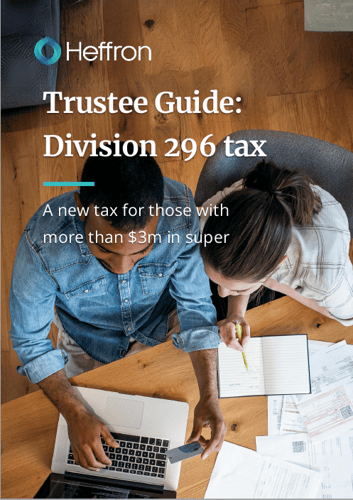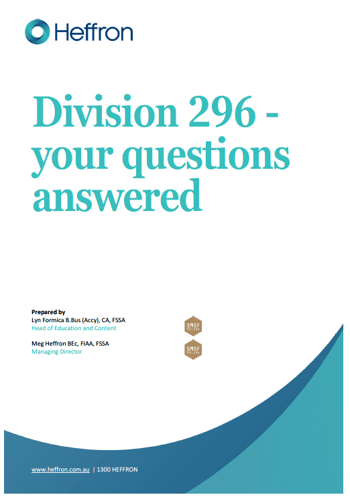Demystify the proposed $3m Division 296 tax
In 2023, the Government announced its intention to bring in a new tax from 2025/26 onwards. With the Albanese Government returned for a second term, the expectation is that Division 296 tax will become a reality.
Division 296 tax is an extra tax that will specifically target people who have more than $3m in super. Naturally, many have questioned whether the introduction of a new tax should prompt them to withdraw sums from their SMSF to bring their balances below $3m.
With uncertainty around this proposed tax and what the best strategy is for those with over $3m in superannuation, Heffron has created the most comprehensive modelling on the $3m super tax in the industry, as well as a guide to help understand how it will impact those with over $3m in super, steps you should and shouldn't consider, what's urgent and what's not.
We can help you in many ways
Trustee Guide
We’ve written a free guide for SMSF trustees/members explaining how the tax is proposed to work.
Division 296 FAQs
Covering all the questions you may have including proportion, contributions, withdrawals, strategies and more.


Private Online Training
Would you like us to deliver a Div 296 focused training session specifically for your team?
Consultation
Still have questions after reading our guide or attending our webinar?
Tap into our expertise by the hour. We are available for a phone consultation or meeting with you or your clients.
$605 per hour (incl GST)
Documentation
Intending to take a withdrawal from super?
Let us prepare compliance documentation to record the payments.
Commonly asked questions
Our experts have compiled some of the most common questions we've received on the Division 296 tax. For more in-depth Q&As, we have a wealth of information in Super Companion.
In a nutshell, if it’s introduced as proposed, Division 296 tax will be a brand new tax that is related to superannuation but is completely separate (and on top of) all existing fund and personal taxes. The Government intends to apply this tax from 2025/26 onwards.
In any given financial year it will only apply to people who have more than $3m in super at the end of the year (ie, 30 June 2026 for the first year of operation, 2025/26).
It will be calculated as :
15% x a proportion* x superannuation earnings*
(* we’ll talk more about these terms shortly)
It will be a personal tax – ie the bill will initially go to the individual (or their personal tax agent) not their super fund (or their super fund’s tax agent).
Individuals will have 84 days to pay the tax but they can choose how they pay it. They can pay their Division 296 tax personally or elect to have the money released from their super fund. Even people who can’t normally access their super yet (because they’re too young) can elect to have this tax bill paid from their super.
People who have a particular type of super entitlement called a “defined benefit” will be able to defer paying any Division 296 tax that relates to their defined benefit until they start drawing on their defined benefit super (eg they start receiving a pension or are paid a lump sum).
Division 296 tax depends on how much someone has in super - so this is a critical figure. The technical term for it is “total superannuation balance” (or TSB).
For most of us, it’s just the amount that shows on our superannuation member statement each year (or adding up several member statements for people who have super in multiple different accounts or funds). Sometimes it can be different – more on that in a moment.
TSB is actually an amount used for lots of things. For example, people with very high TSBs (more than $1.9m at 30 June 2024) can’t make any non-concessional contributions in 2024/25 without facing extra taxes for going over the cap on these contributions. And there are other special tax rules are only available to people with TSBs below particular thresholds.
As part of the Division 296 changes, the Government also plans to make some changes to TSB more broadly – see our blog "Division 296 – more than just a new tax" below for more information. Those changes will flow through to all the other things like contributions as well.
However, there is one specific modification to TSB when it comes to Division 296 tax. Certain members who have super in an SMSF that has borrowed using a “limited recourse borrowing arrangement” (LRBA) since 1 July 2018 have some or all of the outstanding loan amount added to their normal super balance to work out their TSB. This “add back” will be excluded from the TSB used for Division 296 tax purposes.
TSB at the end of the financial year - $3m
TSB at the end of financial year
The formula is essentially trying to work out the proportion of the member’s total balance which exceeds $3m. The tax will then apply to only that proportion of the member’s superannuation earnings (rather than all of them).
For example, Brad’s balance in superannuation (his TBS) at 30 June 2026 is $5.5m. The proportion of Brad’s earnings in 2025/26 which is subject to the Division 296 tax is calculated as:
($5.5m - $3m) ÷ $5.5m = 45.45% (rounded to 2 decimal places)
However, if Michael’s TSB at 30 June 2026 is $3.1m. The proportion of Michael’s earnings in 2025/26 which is subject to the Division 296 tax is calculated as:
($3.1m - $3m) ÷ $3.1m = 3.23% (rounded to 2 decimal places)
Importantly, when it comes to calculating this proportion, it doesn’t matter if the member’s TSB was less than $3m at the start of the year. It is only the end of year figure that impacts how much of their fund earnings are subject to the Division 296 tax.
It also doesn’t matter how much has been withdrawn from or contributed to superannuation during the year when calculating the proportion. Withdrawals and contributions are included for the purpose of working out earnings but not the proportion.
For example, Sally’s balance in superannuation at 30 June 2026 is $3m. It was $3.5m at 30 June 2025 but she withdrew $600,000 during 2025/26. The proportion of Sally’s earnings in 2025/26 which is subject to Division 296 is calculated as:
($3m - $3m) ÷ $3m = 0%
That is, Sally’s withdrawal of $600,000 is not added back when calculating her proportion. Sally will not have any Div 296 tax to pay for 2025/26 regardless of her earnings in that year because her balance is $3m or less at 30 June 2026.
“Earnings” are not calculated in the same way as the fund’s taxable investment income. Broadly speaking, “earnings” in a super fund when it comes to Division 296 tax is anything (apart from contributions) that makes a member’s super balance go up, less anything (apart from withdrawals) that makes their balance go down.
For example, Brad’s super increased from $5m to $5.5m during the year. He didn’t make any new contributions and he didn’t take any money out of his fund (such as pension payments). The growth in Brad’s balance all came from growth in the fund’s assets and income such as interest, rent and dividends.
His “earnings” for Division 296 tax would be $5.5m less $5m, ie $0.5m.
Importantly, this is all of the growth in Brad’s total super balance (TSB) – even growth from unrealised gains in his fund’s assets.
But what if instead, some of the growth in Brad’s TSB had come from contributions? Or Brad had taken payments from his pension or accumulation account? There’s a formula to adjust for that.
For example, if Brad made a $300,000 downsizer contribution and took $100,000 in pension payments during 2025/26, his earnings in 2025/26 would be: $5.5m + $100k - $300k - $5m = $300k
In other words, the growth in his balance ($5.5m - $5m) adding back his pension payments of $100k (because clearly his balance actually grew by even more than $500,000 if there’s still $5.5m left after taking these payments) and then reducing by his contributions (because some of the growth in the balance came from new money he put in – it wasn’t “earnings”).
Importantly though, this is still all the growth in his super that has come from his investments.
And what would Brad’s Division 296 liability be?
15% x the proportion (45.45%) x earnings ($300k) = $20,500 (approx.)
I’ve heard that “earnings” includes unrealised capital gains. Is that right?
Yes. “Earnings” for the purpose of the Division 296 tax doesn’t just include the income the superannuation fund would normally pay tax on – things like interest, rent, dividends or capital gains on assets it’s actually sold.
“Earnings” for Division 296 tax includes everything that causes the member’s account balance to go up – and that will include increases in the value of the assets their fund holds even when it hasn’t sold anything (ie unrealised capital gains).
Capital gains are part of the “earnings”, do they get the normal 1/3rd discount that applies to capital gains when they are taxed in a super fund?
No. Earnings for Division 296 is pretty much any growth in a member’s super account from their fund’s investments. So it includes all of the growth in assets (capital gains) with no discounting.
When assets are eventually sold, is there a capital gains tax credit for the Division 296 tax that’s already been paid?
No. Fund tax is entirely separate to Division 296 tax and will continue with no change. When the assets are sold by the super fund, the capital gains will be taxed in exactly the same way regardless of whether or not the fund’s members have paid Division 296 tax along the way.
Doesn’t that mean capital gains are taxed twice? Once under Division 296 and then again when the assets are sold?
Yes – but that was the Government’s intention. They proposed Division 296 tax as an entirely separate (and additional) tax.
What if assets go backwards, is there a Division 296 tax refund?
No. If a member’s super balance falls they might create a loss they can carry forward for Division 296 tax purposes and it can be used to reduce future Division 296 tax amounts but there is no refund.
Consider Brad, from our earlier example, with a $5.5m TSB at 30 June 2026. What if – in the following year – Brad’s fund sells some of its assets and ends up getting much lower prices than the trustee anticipated. At 30 June 2027 Brad’s TSB is only $5.2m after taking $100k in pension payments?
In 2026/27 Brad’s earnings for Division 296 tax will be:
$5.2m + $100k - $0 - $5.5m = -$200k
In other words, Brad’s earnings are actually a $200k loss.
Unfortunately Brad won’t get a tax refund – Brad will just be allowed to carry this loss forward and use it to reduce earnings in a future year.
Remember that in future years, Brad’s earnings for Division 296 tax will reflect anything that causes Brad’s TSB to increase. This will include not just growth in the value of the fund’s assets but also other income the fund earns such as interest, rent, dividends etc
Do all withdrawals count – or just pension payments?
The “Withdrawals” that are added back when calculating earnings for this tax include anything the member has taken out of super – pension payments, commutations, lump sums from an accumulation account, “release authority” amounts (ie, amounts paid to the tax office because the member went over their contribution cap or had other taxes such as Division 293 or Division 296 tax).
What about inheriting a spouse’s super?
When a member of a couple dies, “something” needs to happen with their super. But the impact on the beneficiary’s Division 296 tax depends on how they get the money.
Firstly, if it is paid out of the super system entirely, inheriting super from someone else has no impact on the beneficiary’s Division 296 tax.
Where that changes is if the money stays in super and is paid to the beneficiary as a pension. The most common example here is when it’s paid to the spouse – either automatically continuing a pension that was already in place for the deceased (a “reversionary pension”) or starting a new pension for the beneficiary from the deceased’s super.
In both cases, the deceased’s super effectively becomes part of the beneficiary’s super – and so it counts for Division 296 tax.
Importantly the initial “inheritance” is treated as a contribution (so that means it doesn’t form part of the beneficiary’s earnings in that year). But of course it will mean their total super balance goes up – increasing their Division 296 tax if they’re already paying it or perhaps putting them into Division 296 territory for the first time.
For example, Paul has $2.5m in a superannuation pension at 30 June 2025. During 2025/26, Paul’s spouse (Kim) dies and Paul inherits Kim’s $2m pension.
Paul decides to keep the reversionary pension running and rolls his own pension back to accumulation - leaving all the money in superannuation. During the year Paul’s balance increases with earnings, Paul takes pension payments of $100,000 and at 30 June 2026 Paul has a total of $4.2m in superannuation.
All of a sudden someone who never expected to be included in this measure will be.
News and Insights
Division 296 tax, legacy pensions and reserves – a real dilemma
For someone impacted by the extra tax on those with more than $3m in super (known as Division 296 tax), it’s not necessarily smart to withdraw large amounts from super before 30 June 2025. But this deadline might be important for some pensioners (or ex-pensioners) in SMSFs.
Published: 13 May 2025
What to do now to beat $3m super cap
The government’s proposal to add extra taxes for those with more than $3 million in their super account has certainly drawn much attention. Regardless of your views on the policy, it’s worth thinking about whether there are steps to take to prepare for it. What should those likely to be affected be doing now?
Published: 15 November 2023
When should my super be under $3m to avoid the proposed new tax?
A common question from our clients about the proposed new tax for people with more than $3m in super has been : if I want to make sure it doesn’t apply to me, does my super need to be below $3m on 30 June 2025 or 2026?
Published: 3 October 2023
Looking for different education and support solutions for your business? See our full range here.


